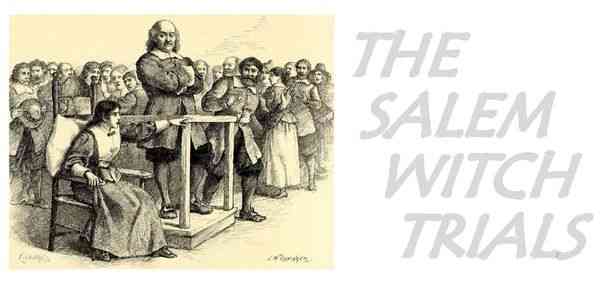In earlier times, a confession was considered to be an act of redemption from the guilt. Church’s teachings preferred that, accused confessing asks for forgiveness and promises not to engage in any sin and, therefore, shall be absolved from the punishment. Apologize and name other accomplices to go free or rather get hanged, was the choice given to those facing the Salem Witch trials.
Although, the history has witnessed several witch trials yet the Salem Witch Trials was one of the most infamous events in the colonial era between 1692 and 1693. In a small village, Salem, Massachusetts, the incident involved a series of accusations and persecutions where several innocents were made to suffer and a few were even tortured to death against the suspicion for practicing witchcraft. A belief was quite prevalent at that time that - a ruined reputation could mean a ruined life in Salem.
Background
Witches are considered to be the followers of satanism who have traded their souls for the devil’s assistance. It was even believed that people worshiped the devil and practiced sorcery in order to inflict harm on others. Earlier the practice was more prevalent and many people were executed for practicing witchcraft between 14th century and 18th century. Something similar had happened in Salem. However, it was more of a result of paranoia about supernatural, misdirected religious fervor and flawed justice system where the repentance of guilt prevailed over the truth.

The event began in the winter of 1692 when two cousins, Elizabeth Parris (9 years old) and Abigail Williams (11 years old), started behaving strangely and getting fits including vomiting and muscle contractions. They were suspected to be possessed by some kind of demonic power by a local doctor, William Griggs, who could not diagnose any physical disease. Another girl, Ann Putnam, who was 11 years old, along with the other two girls, were also reported with similar symptoms.
Have you heard of the Rainbow Project? Click below to learn more:

The people of Salem village believed that the devil wreaked chaos in the world through agents or witches, who destroys the nature and conjure demon spirits and convert children into witches.
On account of many such similar incidents, a special committee was constituted to investigate the perpetrator behind this havoc. The committee questioned all these “young” girls. Under the pressure of magistrates Jonathan Corwin and John Hathorne, on 29th February, four girls named – a Caribbean Slave, Tituba, a homeless beggar Sarah Good and an old women Sarah Osborne and alleged them for afflicting the said girls. Subsequently, all three women were arrested based on the accusation by a few young girls for practicing witchcraft.
These three women were then interrogated and tortured for days. Good and Osborne pleaded not guilty whereas, Tituba denied harming the girls at first, but then she confessed to practicing witchcraft on the devil’s orders and even mentioned that Good and Osborne were too involved with her. She said- she had a vision of black dogs, red cats, yellow birds and an apparition of a man who made her sign on a book and claimed that even many other women had signed on the alleged “witch contract.” On the further confessions by Tituba, soon, many other women were arrested who included Church’s upstanding members and, among other things, was Sarah Good’s 4-year-old daughter. She was arrested on suspicion of having some demonic powers. Among all the arrested women, a few of them started to confess that they have encountered the devil and they had signed on the witch contract as well and a stream of accusations had begun.

The authorities cited that the accused "witches" were told that- they would be freed if they confess otherwise, they will be prosecuted as to save themselves from the punishment these women than started accusing other women like Tituba. Considering the increase in such cases the new governor, William Phipps, appointed a Special Court of Oyer (to hear) and Terminer (to decide) where the sentencing of these witches will be done. The situation got aggravated when, on 10th June, Bridget Bishop was hanged for the guilt of practicing witchcraft at what today is known as Gallows Hill.

Many believe that the accusations had started to spread beyond Salem,and even the most influential figures were the targets. When his wife was accused of practicing witchcraft, it was then, and Governor Phipps suspended the trials. Prisoners were released and arrests had stopped. Another belief is that amidst the trials and execution, an aged man, who was accused of witchcraft, was wrongly tortured till death by putting him under massive rocks eventually despite claiming his innocence. After this incident on 3rdOctober, the president of Harvard promulgated a law under which no spectral evidence shall be admissible. He believed that – It were better that ten suspected witches should escape than one innocent person be condemned. After this, all the falsely accused "witches" were set free ending the inhumane witch trials.
Loving the article? Consider buying the author a lunch by donating here
Tituba was released in May 1693, but Sarah Osborne could not survive while Good was hanged before the new order. In these trials, over 200 people, accused of practicing cult practices, were sent to the jails where they were tortured and fourteen women and six men had been executed.
Critical Analysis
Some might wonder that, why did they set the “witches” free when they confessed their guilt of practicing witchcraft? What if they again start their immoral practices?
The answer to these questions is based on a human psychological tendency. Tituba, Sarah Good and Sarah Osborne were in some or the other manner persecuted people who were ill-treated by the other people and neither of them attended church regularly. When those young girls were forced to tell the names of the ones they believe to practice witchcraft, being young girls, they named these three women whom they might not like because of their appearances or their behavior or whatsoever. The officials made these “witches” confess accomplice on the promise of letting them free if they name other “witches.” Thus, due to the fear of prosecution, they accepted that they practiced witchcraft and started accusing other women.
So, perhaps no one was a “witch,” but instead to seek revenge or to avoid further punishment, they confessed names of other people and those who did not confess were executed. This turned into havoc.
Another quite intriguing question is, what caused the strange behavior in those children?
Some have speculated that those girls were suffering from hallucinations caused by fungus or a condition that caused swelling of the brain. Basically, in the geographical location of Salem, a different type offungus ergot is found in wheat or rye, and Modern scientists suggest that anyone who eats such fungus gets fits, vomiting, hallucination and muscle contortion, precisely what happened to those girls. However, these are just speculations and the ultimate cause of their such behavior is unknown.

Nonetheless, even identifying the flaws of such an event, the suffering of over 200 people cannot be reckoned. It is more crucial to realize the danger of group perception, public hysteria and scapegoating. Although the false implication might have helped Tituba but it costed lives of many other women. It is indeed tough to decide who’s right and who’s wrong but truth shall always prevail in every circumstance.
Aftermath
On 14th January 1697, the court ordered one day fasting in remembrance of the victims of these trials. In 1711, these 20 victims’ names were carved in goodwill and their families were compensated with 600 Euros as compensation. After almost 250 years in 1957, the Massachusetts government formally apologized for the trials.
The event of 1692 has remained a powerful symbolism for anarchy and manipulation of public religious and political fervor. Its references could be seen in many literature and dramas, one of the major works being Arthur Miller’s - The Crucible (1953), where the event was used as an allegory of the anticommunist movement lead by Joseph McCarthy.
In August 1992, Nobel Laureate Elie Wiesel dedicated the Witch Trials Memorial in Salem to mark the 300th anniversary of the trials.

Recommended reading:

References
[1] Salem witch trials; Britannica.com
[2] A Brief History of the Salem Witch Trials; SmithsonianMag.com
[3] What really happened during the Salem Witch Trials - Brian A. Pavlac; Ed.TED.com
[4] The Crucible: Act 1 (Summary & Analysis); Litcharts.com
[5] Salem witch trials; Wikipedia


